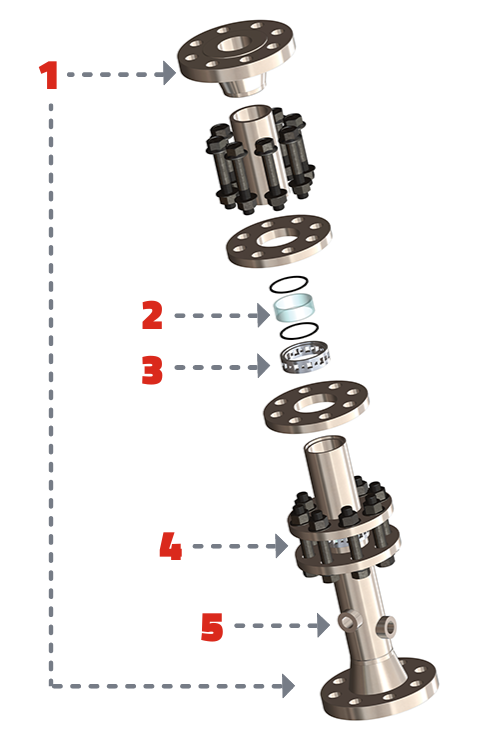Researching a green-tech solution for extracting cleaner oil and gas.
It’s one thing to have a brilliant idea. It’s quite another to turn that idea into a working piece of equipment that could revolutionize Alberta’s energy industry.
That’s at the root of the partnership between Impossible Sensing Energy (ISE) and SAIT’s Centre for Innovation and Research in Advanced Manufacturing and Materials (CIRAMM), a research hub within Applied Research and Innovation Services (ARIS).
In 2020, ARIS established CIRAMM to identify and address challenges faced by industry as manufacturing and materials become more complex. With multiple industries simultaneously implementing multiple technologies such as artificial intelligence, quantum computing and robotics, CIRAMM’s mission is to facilitate innovation and talent.
This CIRAMM / ISE project, called FLOW, involves the design, manufacture and testing of a multiphase flow meter for the oil and gas industry. The goal is to create a prototype that measures mass and volumetric flow rates of oil, gas and water at individual well heads during the petroleum production process. But, while multiphase flow meters are not a new concept, part of what makes a FLOW meter unique (beyond the fact it uses the same optical imaging technology ISE provided for NASA’s search for life on Mars) is that more oil and gas producers could afford to buy one.
“When ISE came to CIRAMM with their idea, I was really excited,” says Evan Altenhof (AMAP ’16, CNCO ’13, MDT ’11), Research Lead with CIRAMM. “It not only has a clear economic benefit to the energy industry, but also a clear environmental benefit.”
ISE co-founder and CEO, Ariel Torre, says: “The flow meter we have designed breaks the cost barrier and provides a full view of what each well is producing, allowing companies to accurately optimize production in real time. It will also reduce trips to the field, keeping crews safer.” And, he says, “We think the long-term value driver will be environmental impact. The separators currently used in this process are driven by compressed air or pressurized natural gas — a known source of greenhouse gas emissions.
“Conventional separators are also massive. The flow meter we are building will replace equipment that is the size of a car, with a flow meter that can easily fit into a car’s trunk.”
CIRAMM researchers started the project by collecting information from ISE and other stakeholders.
“Once we had a concept that incorporated all their elements, we moved into the 3D modelling phase. Then we conducted tests and computations to help analyze how this would function in the real world before building a prototype,” says Altenhof. “We machined all the parts and we’re ready for the testing phase.”
Nikolai Koutaitsev (METN ’22) was the project’s Mechanical Designer. A SAIT student at the time, he met frequently with ISE to discuss their needs, work through technical challenges and generate detailed drawings — like the one below — for CIRAMM's manufacturing team.
"The FLOW meter uses pioneering optical sensing technologies to continuously monitor the velocity, temperature and chemical composition of petroleum fluid coming out of an oil well head, with no interruption to the flow," says Koutaitsev. LINK asked him to explain FLOW’s innovative components:

.
- Industry standard flanges at each end of the meter allow it to be attached to any standard pipeline.
- As fluid flows through the meter, a clear, single-crystal sapphire glass ring — strong enough to withstand the fluid's pressure — acts as a window into the pipe for electronic sensors to "see" the internal flow.
- A solid aluminum ring — machined on a 5-axis CNC machine — sits atop the sapphire glass and holds optical sensors necessary for gathering data from the fluid.
- Custom flanges clamp the sapphire glass and electronics holder between two pipe sections, allowing for untierrupted fluid flow.
- National pipe thread (NPT) bungs ensure temperature and pressure sensors are securely mounted as they monitor conditions inside the FLOW.
ISE is so pleased with its relationship with CIRAMM that there are more projects in the works, including one that would allow real-time measurement of emissions from an entire oil field.
Altenhof says working with ISE has been an excellent fit for CIRAMM. “Their technology is novel and it’s already on industry’s radar, so it’s exciting knowing it might be utilized in the field in the future.” And, he adds, “It is also in line with CIRAMM’s strategic goals. It’s the kind of partnership we really like to develop.”
This story was originally written for the print version of the Fall 2022 issue of LINK magazine.

Oki, Âba wathtech, Danit'ada, Tawnshi, Hello.
SAIT is located on the traditional territories of the Niitsitapi (Blackfoot) and the people of Treaty 7 which includes the Siksika, the Piikani, the Kainai, the Tsuut’ina and the Îyârhe Nakoda of Bearspaw, Chiniki and Goodstoney.
We are situated in an area the Blackfoot tribes traditionally called Moh’kinsstis, where the Bow River meets the Elbow River. We now call it the city of Calgary, which is also home to the Métis Nation of Alberta.
